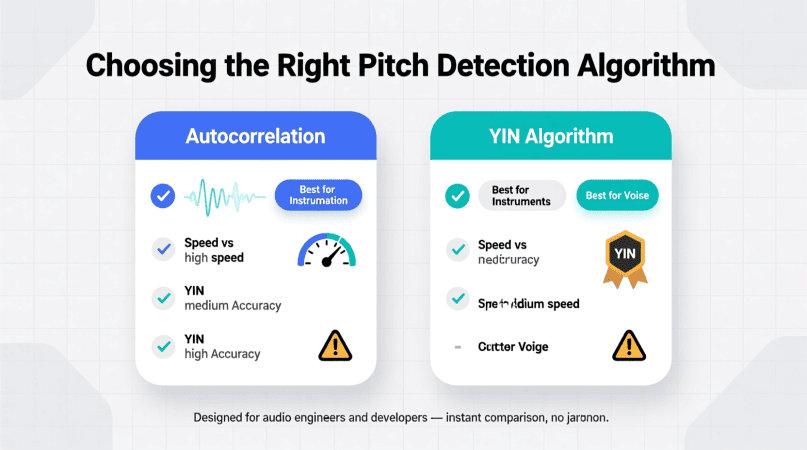
If you’ve ever tried to detect pitch in real time—whether for singing practice, instrument tuning, or building an app—you’ve probably come across two methods: autocorrelation and the YIN algorithm.
Both belong to the time-domain family of pitch detection techniques, and both aim to estimate the fundamental frequency (F0) of a sound. But they don’t perform the same way, and choosing the right one depends on your goals.
In this guide, we’ll break down the differences, look at where each shines, and give you practical advice on when to use autocorrelation vs YIN.
What Is Autocorrelation?
Autocorrelation measures how similar a signal is to itself when shifted in time. For pitch detection, it works by finding repeating patterns: the time lag where the signal best matches itself corresponds to the period of the pitch.
- Strengths:
- Simple to implement.
- Handles monophonic signals like voice or single instruments well.
- Tolerant of harmonic-rich signals compared to raw FFT.
- Weaknesses:
- Susceptible to subharmonic errors (detecting half or double the actual pitch).
- Can be computationally heavy for long windows.
- Accuracy falls in very noisy recordings.
Think of it as an “echo matcher”—it looks for repeating cycles in the waveform.
What Is the YIN Algorithm?
The YIN algorithm was designed to improve on autocorrelation while keeping things efficient. It introduces three key refinements:
- Difference function – Instead of measuring similarity, YIN calculates how different the signal is at each lag.
- Cumulative mean normalization – Reduces false positives by smoothing out the difference curve.
- Threshold and parabolic interpolation – Finds the true pitch period with more precision.
- Strengths:
- Higher accuracy, especially at low pitches.
- Fewer octave (subharmonic) errors.
- Lightweight enough for real-time use.
- Weaknesses:
- Slightly more complex than basic autocorrelation.
- Still challenged by extremely noisy audio.
Try Our: note to frequency converter
Side-by-Side Comparison
| Feature | Autocorrelation | YIN Algorithm |
|---|---|---|
| Accuracy | Good, but octave errors | Excellent, fewer errors |
| Noise Robustness | Moderate | Higher |
| Computational Cost | Low–Moderate | Moderate, but optimized |
| Implementation Ease | Simple | More complex, but manageable |
| Real-Time Use | Feasible | Feasible and more reliable |
When Should You Use Each?
- Choose autocorrelation if you want something simple, are building a basic tuner, or don’t need extreme accuracy.
- Choose YIN if you’re developing a real-time singing trainer, want fewer pitch detection errors, or need robust results across a wide vocal range.
Try Our: audio pitch detector (wav/m4a)
FAQs About Autocorrelation vs YIN
Q: Why is YIN considered more accurate than autocorrelation?
Because YIN uses normalization and interpolation to reduce octave errors and pinpoint the true pitch period.
Q: Can autocorrelation still be useful?
Yes. For simple tasks or educational projects, autocorrelation is easy to code and works well enough.
Q: Which is better for noisy environments?
YIN generally performs better, but both benefit from pre-filtering or noise reduction.
Q: Is YIN real-time ready?
Yes. It was designed to be efficient and is used in many real-time audio applications.
Pitch Detector is a project by Ornella, blending audio engineering and web technology to deliver precise, real-time pitch detection through your browser. Designed for musicians, producers, and learners who want fast, accurate tuning without installing any software.
